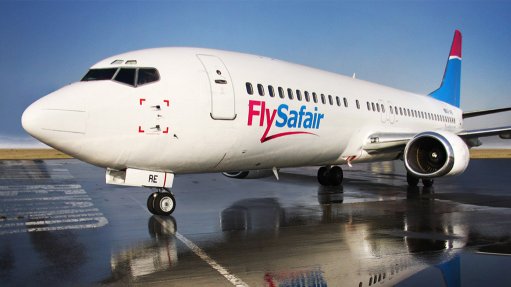
Flight tickets for a new low-cost airline, FlySafair, are set to go on sale next month, as aviation specialist Safair extends its reach further into South Africa’s domestic aviation market.
Following South Africa’s Air Service Licensing Council approval, the group aimed to offer up to ten flights a day between Johannesburg and Cape Town, using two Boeing 737-400 aircraft, with full operations to be under way by the last quarter of this year.
“Although many people have commented that the airline industry is an unfavourable environment for new entrants at the moment … we have been flying commercially for almost half a century already and we have no doubt that FlySafair will only serve to further grow the domestic market,” Safair CEO Dave Andrew said in a statement on Tuesday.
Earlier this year, International Air Transport Association (Iata) director-general and CEO Tony Tyler said African airlines continued to be the weakest performers, with passenger loads below 70% and operating margins averaging less than 1%. But it was an improvement over 2012.
Rising fuel costs, which had increased by 55% since 2006, and a weakening economy had, however, placed strain on the industry.
The launch of FlySafair also followed the failure of several potential low-cost airlines to take off since the demise of 1time last year.
Aim-listed low-cost airline Fastjet, in June, also mothballed plans to place its own airliners in South Africa’s airspace.
Through a 25:75 partnership with South African investment company Blockbuster, Fastjet would have leveraged charter operator Federal Airlines’ existing licensing infrastructure.
Fastjet, which had initially aimed to take over 1time’s licence, said it wanted to direct all its efforts and resources to starting its international services as soon as possible.
Further, an attempt by the South African National Taxi Council to launch the low-cost Santaco airline at Lanseria airport at the end of 2011 had also failed to materialise.
The association had aimed to close the low-cost market gap in an “all-in-one transport system between taxi ranks in different provinces”.
However, Safair already had a foothold in the market through its position as a commercial support partner for most local airlines.
The aviation group had been contracted to operate the other airlines’ schedules, with Safair’s own unbranded aircraft and crew operating under the banner of the airline being assisted, whenever an aircraft was out of service owing to technical reasons or crew shortages.
Andrew also pointed out that, since the early eighties, Safair has partnered with international aid groups, such as the International Committee of the Red Cross, the World Food Programme and the United Nations, providing flights and carrying goods and supplies into the rest of Africa – and other parts of the world – as part of their commitment to corporate social investment.
“We are extremely excited about this new chapter in Safair’s history and we look forward to further being of service to South Africa’s flying public,” he concluded.